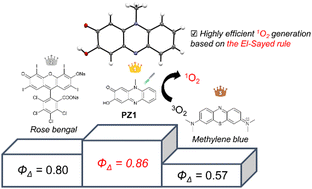Synthesis and optical properties of phenazinone-based photosensitizers for singlet oxygen generation†
Abstract
Phenazinone derivatives PZ1–3 where a carbonyl group is incorporated into the chromophore are designed and developed as halogen-atom-free-heteroanthracene-based photosensitizers possessing the ability to generate singlet oxygen (1O2). Compared to the phenazine-2,3-diol (PZ) without a carbonyl group, the molar absorption coefficients of PZ1–3 at around 480 nm increased by a factor of five to six. Furthermore, the values of fluorescence quantum yields (Φfl) of PZ1–3 were significantly low (0.03 for PZ1, 0.04 for PZ2, and 0.05 for PZ3). To evaluate the 1O2 generation ability of PZ1–3, the 1O2 quantum yields (ΦΔ) of PZ1–3 were estimated and it was demonstrated that PZ1 exhibited a higher ΦΔ value than rose bengal (RB) known as a reference photosensitizer to generate 1O2 (0.86 for PZ1, 0.54 for PZ2, 0.069 for PZ3, and 0.68 for RB). Moreover, the rate constants (kr, knr, kISC, and kIC) of PZ1–3 indicated that the reason for the low ΦΔ of PZ2 and PZ3 comes from the vibrational relaxation caused by a flexible methoxymethoxy and 4-chlorobenzoate group, respectively. Density functional theory (DFT), time-dependent DFT (TD-DFT), and natural transition orbital (NTO) calculations suggested that for PZ1–3, the intersystem crossing (ISC) processes from the lowest excited singlet state (S1) to the third triplet state (T3) are thermodynamically feasible and facilitated based on El-Sayed's rule. Consequently, we propose that the phenazinone skeleton is one of the promising halogen-atom-free-heteroanthracene-based chromophore photosensitizers.



 Please wait while we load your content...
Please wait while we load your content...